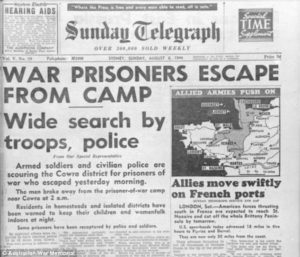
1944
The Night of 100 Suicides
Japanese prisoners of war were, relatively speaking, a rare phenomenon in World War II. Schooled in the ethos of the bushido warrior code, Japanese soldiers much preferred death to dishonour and would almost always fight to the last man or commit suicide rather than surrender.
In Cowra POW Camp in New South Wales, Australia, 4,000 enemy soldiers and interned civilians were held: Japanese, principally from captured merchant ships, Koreans, political prisoners from the Dutch East Indies, and Italians, captured in the North African campaign. The latter were the happiest of the captives, often allowed out into the community on their own or in work details, many of them making friends (and lovers) among the local population. The Japanese, however, were troublesome and resentful. Unlike the Italians, they were not trusted outside the camp, but otherwise were well treated according to Geneva Convention rules, quite unlike the barbarous conditions faced by Australians captured by the Japanese.
About 2 in the morning of 5 August 1944, a bugle sounded, and over a thousand Japanese erupted from their barracks, armed with makeshift weapons, and attempted a mass escape, the largest ever tried during the war. Shouting “Banzai” they threw themselves at the barbed wire fences. With blankets, baseball gloves and bare bodies, they neutralized the wire and assaulted the few guards in human wave attacks. Inside the barracks, a dozen prisoners had hanged themselves while others set fire to the compound. At the cost of hundreds of lives they overwhelmed their captors and escaped into the night. They scrupulously observed their commanders’ instructions to harm no civilians but they resisted any attempt at recapture. It took four days to round up the escapees, though more were killed in the process and more committed suicide. In the end, the casualty list read four Australian dead, 231 Japanese killed, and 108 wounded.
A military court of inquiry determined
- that conditions at the camp were fully in accordance with the International Convention;
- that no complaints regarding treatment had been made by or on behalf of the Japanese prior to the incident, which appeared to have been a premeditated and concerted plan of the prisoners;
- that the actions of the Australian garrison in resisting the attack averted greater loss of life, and that firing ceased as soon as control was assured; and
- that many of the dead had died by suicide or by the hand of other prisoners, and that many of the wounded had suffered self-inflicted wounds.
A survivor explained the motivation for the events: “the soldiers has been brainwashed to believe that only a shameful coward with no right to exist would ever surrender in wartime. Even their families often couldn’t accept defeated troops returning home, and they were often treated like fearful ghosts and driven away.” Today Cowra has become a place of pilgrimage and friendship for the Japanese people, and is the location of the only Japanese War Cemetery in Australia, containing the graves of those Japanese killed in the breakout.